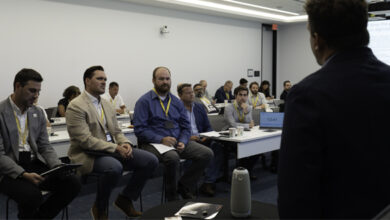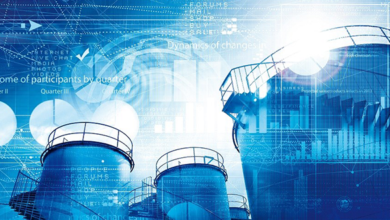New data transfer protocol aims to bring Netflix streaming speeds to offshore drilling operations
Equinor set to commercially deploy Energistics Transfer Protocol with 2 new monitoring centers opening this year
By Sarah Junek, Associate Editor
Imagine driving your car using only the rearview mirror for steering. Similarly in drilling, large amounts of data are being collected at the rig site, and experts in onshore offices are assigned to analyze that data and assist in deciding what happens next. Yet, data transfer from offshore rigs to shore can be delayed anywhere from tens of seconds to tens of minutes.

This lag is due to the commonly used data transfer method for drilling measurement data, known as Simple Object Access Protocol (SOAP). It inherently acts as a bottleneck by its use of server relays that have to handle call and response protocols, according to Energistics Consortium, a global nonprofit oil and gas industry organization that develops and maintains collaborative technology standards.
Getting that much information to staff onshore in real time, typically considered one second or less, is impossible with the current standard protocol, said Philip Neri, Marketing Director for the firm. Adoption of a new data transfer protocol could change that, however, so that teams of onshore experts in multiple locations could see and talk about the same data at the same time.
In a pilot program, members of Energistics tested current SOAP data transfer against the Energistics Transfer Protocol (ETP), released in 2016. The pilot found that ETP has a system latency – the time between when data is transferred and when it can be used – of an average 1.2 seconds from the offshore rig to the onshore control site. That compares with 10-15 seconds with SOAP.
The way ETP moves data is modeled after streaming video, said Ross Philo, Energistics CEO, who compares ETP to media streaming service Netflix.
Instead of storing blocks of data at the rig and waiting for a query before sending it to an onshore control center in bursts, ETP doesn’t wait. It instructs the data source to constantly send changes or new data as they occur. This behavioral change eliminates the added traffic of continuously polling servers, which, as well as being slow, creates a problem of bandwidth saturation as data volumes increase.
Energistics is seeing its first known commercial adoption of ETP set in motion with the news of Equinor’s two onshore monitoring centers opening in the first part of this year. The centers are opening after successful pilot tests of ETP in 2017 quantified previously unknown delays that were happening while using SOAP. The tests also revealed that ETP could transmit the same data as SOAP using one-tenth of the bandwidth. “This isn’t just a new version of what’s already running. This is revolutionary,” Mr Neri said. “It completely changes the game of how you’re going to work between your onshore team and your rigs.”
The protocol also would allow people in locations other than the onshore control centers to look at the same data in real time, Mr Neri said.
The pilot test was a joint project involving Equinor, Baker Hughes and Kongsberg Digital. All are members of Energistics Consortium, which also includes other companies involved in qualifying the industry standard WITSML data exchange format associated with the ETP-based transport mechanism.
The pilot included direct comparisons of WITMSL using both SOAP and ETP transfer protocols, encompassing a comparison of improvements in data assurance metrics and recovery of cached data updates after breaks in transmission. The WITSML-compliant workflow provided data from the Songa Equinox semisubmersible on the Troll field, offshore Norway, to Baker Hughes’ control center in The Netherlands and a Kongsberg aggregator before being delivered to the Equinor control room.
It was using a fiber-optic connection, but the delays observed during the test still “ranged in tens of seconds under the old protocol system,” Mr Philo said. “If you’ve got a monitoring center onshore that is trying to support the offshore operation and they need to respond to a particular event or a formation top… you really need that information in real time,” Mr Philo said.
Data Overload
ETP is able to deliver both better transmission speeds and more data capacity because it transfers data with no overheads. The current protocol aggregates data and transmits it in an entire block through whatever network capacity is available. Even if it is a fast connection with plenty of bandwidth, the current transfer system is slowed down by cumbersome handshaking and buffering around the data transfer process, as well as its method of holding data until a query is made, a wrinkle in delivery that the new method smooths out to a steady flow.
Another factor is that the new system transfers the data in binary format rather than XML, which is character based. The old XML format is not as efficient and not meant to be compacted. With a switch to a binary format, the communication load is more efficient, Mr Neri said. The old transfer inefficiencies get compounded as the amount of new data, made available from high-tech digital drilling tools, increases.
“It’s going to be like drinking from a fire hose, so we’ve just increased the capability of the fire hose,” Mr Philo said. Having more capacity “is really important in today’s era of digital transformation because it means we are seeing more and more data being sent in from offshore on what can typically be quite expensive communication links,” Mr Philo said.
Coming soon, consortium members will be testing the new data assurance information available in ETP. This refers to metadata that provides additional information about the quality of the data being sent. This will reduce the amount of time spent at onshore centers in correction and validation of data. “When you receive information, you really want to know: Does it comes from a trusted source? Does it come from a sensor that’s been recently calibrated? Is that sensor operating within its expected operating range?” Mr Philo said. “In today’s world of artificial intelligence, big data analytics and machine learning, if you’re applying this data in some sort of automated fashion for an analysis, you need to know you’ve got trustworthy data as input to your analysis.”
Safety and collaboration
With the capabilities of the new system, collaboration between rig and onshore-based teams will likely increase as both will be seeing the same data at the same time, leading to efficiency and safety improvements. “In the past, because the data was delayed, the guy on the rig was basically on his own even though he was sending data in,” Mr Philo said. With ETP, the data can also be sent to service companies and sub-contractors who may not be at the onshore control center. This allows an operator like Equinor to incorporate ETP into its plans to reduce the number of personnel needed at the rig site during operations.
In the four months of testing, Equinor noted fewer helicopter trips to the rig, Mr Neri said, a significant cost savings and hazard avoidance even if it was not fully quantified.
Slow adoption of new technologies in the drilling industry is common. With Equinor’s pilot project, it took many years of collaboration with Baker Hughes and Kongsberg to make data-streaming performance improvements a reality. Both Baker Hughes and Kongsberg are now offering ETP v1.1 to complement their data services.
ETP “completely changes the game of how you’re going
to work between your onshore team and your rigs.”
– Philip Neri, Energistics
In 2017, Equinor used ETP to transmit data from wired drill pipe, from a location where satellite bandwidth at the rig was one-tenth of its capacity due to the satellite’s low angle above the horizon. By using ETP, Equinor was able to read the high-resolution downhole data onshore. “Having a higher confidence in the data and being able to combine other data from the subsurface model, along with the real-time drilling information, will ultimately deliver a much more efficient geosteering process,” Mr Philo said. DC





